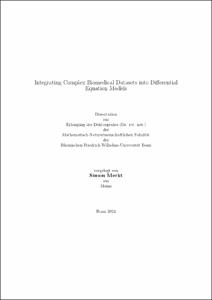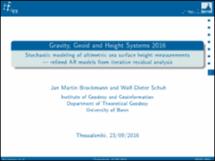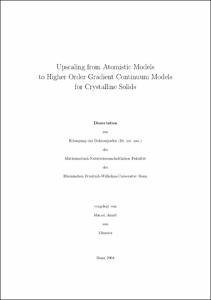Merkt, Simon: Integrating Complex Biomedical Datasets into Differential Equation Models. - Bonn, 2025. - Dissertation, Rheinische Friedrich-Wilhelms-Universität Bonn.
Online-Ausgabe in bonndoc: https://nbn-resolving.org/urn:nbn:de:hbz:5-83675
Online-Ausgabe in bonndoc: https://nbn-resolving.org/urn:nbn:de:hbz:5-83675
@phdthesis{handle:20.500.11811/13202,
urn: https://nbn-resolving.org/urn:nbn:de:hbz:5-83675,
doi: https://doi.org/10.48565/bonndoc-599,
author = {{Simon Merkt}},
title = {Integrating Complex Biomedical Datasets into Differential Equation Models},
school = {Rheinische Friedrich-Wilhelms-Universität Bonn},
year = 2025,
month = jul,
note = {This thesis focuses on developing mathematical models utilizing complex biomedical datasets to understand epidemiological and cell-biological processes. The thesis is divided into three primary research articles and addresses how differential equation models can be applied to enhance insights into disease dynamics and cellular communication processes. The research is motivated by the need to better understand complex biological processes, particularly epidemiological patterns in populations and cellular dynamics. The COVID-19 pandemic highlighted the importance of life sciences in global health and underscored the role of computational methods and mathematical modeling in analyzing biomedical data. Mechanistic models incorporating biological knowledge are chosen over purely data-driven models due to their ability to integrate prior information and predict beyond the available data. The thesis focuses on ordinary differential equations (ODEs) and partial differential equations (PDEs) as tools to model time-dependent biological processes.
The thesis addresses two main research questions:
I. How can mechanistic models enhance classical cohort studies to understand disease dynamics better?
II. How can mechanistic models be utilized to capture communication processes derivedfrom single-cell data?
The research involves integrating data into differential equation models through the following steps:
1. Data Preprocessing: Reducing the complexity of high-dimensional datasets using methods like Principal Component Analysis, diffusion maps, and clustering.
2. Model Construction: Developing ODE and PDE models tailored to specific biomedical phenomena.
3. Parameter Estimation: Using statistical methods and gradient-based optimization techniques to estimate unknown parameters in the models.
4. Uncertainty Analysis: Employing techniques like Markov Chain Monte Carlo to assess the reliability of model predictions.
The thesis consists of three key studies:
A. SEIR Modeling for COVID-19 in Ethiopia: The first study focuses on integrating antibody data into Susceptible-Exposed-Infectious-Recovered (SEIR) models to predict the spread of SARS-CoV-2 in Ethiopia. Three models are developed: a basic SEIR model, an extended SEIR model, and one including a variant model for a new virus strain. Key insights include the impact of healthcare workers’ exposure and the underreporting of infections in Ethiopia.
B. Multivariant and Antibody-Level Modeling: This second study extends the SEIR modeling to a model including multiple virus variants and one focusing on antibody levels. They provide insights into how variant-specific immunity and vaccination affect the spread of COVID-19. The model predicts early and widespread vaccination could have significantly mitigated infection waves in Ethiopia.
C. PDE Modeling of Cell-to-Cell Communication: The final study develops a PDE-ODE model to describe immune cell activation via ligand-mediated communication. Applied to single-cell RNA sequencing data, the model highlights the role of cell-to-cell communication in immune responses and demonstrates the impact of ligand concentration on cellular dynamics.
The thesis concludes that mechanistic models, particularly ODE and PDE systems, are powerful tools for integrating biomedical datasets and providing valuable insights into disease dynamics and cellular processes. Future research could explore incorporating more detailed genetic data to enhance model accuracy or multi-scale modeling, linking within-host viral dynamics to population-level models.},
url = {https://hdl.handle.net/20.500.11811/13202}
}
urn: https://nbn-resolving.org/urn:nbn:de:hbz:5-83675,
doi: https://doi.org/10.48565/bonndoc-599,
author = {{Simon Merkt}},
title = {Integrating Complex Biomedical Datasets into Differential Equation Models},
school = {Rheinische Friedrich-Wilhelms-Universität Bonn},
year = 2025,
month = jul,
note = {This thesis focuses on developing mathematical models utilizing complex biomedical datasets to understand epidemiological and cell-biological processes. The thesis is divided into three primary research articles and addresses how differential equation models can be applied to enhance insights into disease dynamics and cellular communication processes. The research is motivated by the need to better understand complex biological processes, particularly epidemiological patterns in populations and cellular dynamics. The COVID-19 pandemic highlighted the importance of life sciences in global health and underscored the role of computational methods and mathematical modeling in analyzing biomedical data. Mechanistic models incorporating biological knowledge are chosen over purely data-driven models due to their ability to integrate prior information and predict beyond the available data. The thesis focuses on ordinary differential equations (ODEs) and partial differential equations (PDEs) as tools to model time-dependent biological processes.
The thesis addresses two main research questions:
I. How can mechanistic models enhance classical cohort studies to understand disease dynamics better?
II. How can mechanistic models be utilized to capture communication processes derivedfrom single-cell data?
The research involves integrating data into differential equation models through the following steps:
1. Data Preprocessing: Reducing the complexity of high-dimensional datasets using methods like Principal Component Analysis, diffusion maps, and clustering.
2. Model Construction: Developing ODE and PDE models tailored to specific biomedical phenomena.
3. Parameter Estimation: Using statistical methods and gradient-based optimization techniques to estimate unknown parameters in the models.
4. Uncertainty Analysis: Employing techniques like Markov Chain Monte Carlo to assess the reliability of model predictions.
The thesis consists of three key studies:
A. SEIR Modeling for COVID-19 in Ethiopia: The first study focuses on integrating antibody data into Susceptible-Exposed-Infectious-Recovered (SEIR) models to predict the spread of SARS-CoV-2 in Ethiopia. Three models are developed: a basic SEIR model, an extended SEIR model, and one including a variant model for a new virus strain. Key insights include the impact of healthcare workers’ exposure and the underreporting of infections in Ethiopia.
B. Multivariant and Antibody-Level Modeling: This second study extends the SEIR modeling to a model including multiple virus variants and one focusing on antibody levels. They provide insights into how variant-specific immunity and vaccination affect the spread of COVID-19. The model predicts early and widespread vaccination could have significantly mitigated infection waves in Ethiopia.
C. PDE Modeling of Cell-to-Cell Communication: The final study develops a PDE-ODE model to describe immune cell activation via ligand-mediated communication. Applied to single-cell RNA sequencing data, the model highlights the role of cell-to-cell communication in immune responses and demonstrates the impact of ligand concentration on cellular dynamics.
The thesis concludes that mechanistic models, particularly ODE and PDE systems, are powerful tools for integrating biomedical datasets and providing valuable insights into disease dynamics and cellular processes. Future research could explore incorporating more detailed genetic data to enhance model accuracy or multi-scale modeling, linking within-host viral dynamics to population-level models.},
url = {https://hdl.handle.net/20.500.11811/13202}
}









